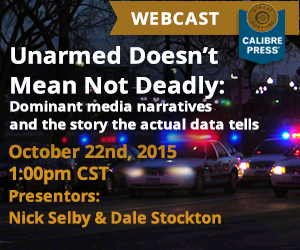[Editor’s Note: This is the first in a series of articles, which will delve into the StreetCred Police Killings in Context (PKIC) database. A few months back The Guardian and the Washington Post published databases and photographs of Americans who have been killed by police. The effect is striking. But, as law enforcement professionals, we wondered: What were the circumstances when the deceased was unarmed? The PKIC is an open database that aims to tell a deeper story by collecting publicly available data–police testimony, witness reports, autopsy and so forth. The results are fascinating. Stick with us in the coming months as we examine what was found and what the implications might be.]
In studying the killings by police of unarmed people in the United States—especially in light of media coverage that is overwhelmingly skeptical of the American cops’ take on things—one of the most important things we needed to consider was where we would get information and how we can know that it is truthful. After all, what good is data if the source is bad?
Ultimately and in short, we used the data that was available—specifically, in most cases, the testimony of the police officer involved. Some excellent journalists raised an issue: In many cases, they said, the cops simply can not be trusted. Absent other evidence, and based on the police’s history of lying, it’s just too difficult to study data that’s primarily based on the word of police.
As a cop, I don’t agree. But I understand their position. And regardless, as a guy who also works with data for a living, I’m always after the most reliable and objective data points available.
But in the real world we must deal with what we have. When it comes to police shootings, the officer’s perspective is an essential, but not singular, component of that story. This is not unique to the U.S.
Might the officer be biased in his or her take? Of course! Every witness is biased. So to correct for blatant bias or at least screen out obvious misperceptions, we have a) implemented a sound design; b) encouraged peer reviews (I even invited some serious data people involved with data in the excellent Mapping Police Violence site —t he invitation still stands); and c) made it easy to correct, update and add to the database.
Another thing we can do is look to the data and see what it tells us about non-police input. We start with the basic count of incidents.
This year, of 125 incidents in which police killed an unarmed civilian, 25% (31) began on traffic stops, and 65% (81) began as a response to a 911 call about a violent-crime (robbery, carjacking, domestic violence orassault) or property crime (burglary, car theft or vandalism) in progress. There were 9 people (7%) whom 911 callers described as being, “crazy,” or, “on drugs”, “covered with blood”, and “yelling”, or threatening people. Three (2%) were wanted fugitives in the act of escape — and one was unarmed when he died but was acting as part of a gang of three who were wanted in a recent homicide and were at the time of the incident in the progress of a kidnapping a woman. One was a training incident in which one cop shot another accidentally.
So in nearly three of four of cases, the police were called by someone else for help. These were not self-dispatched and the police didn’t select the person who ultimately died (we will dig into the incidents that began on traffic stops soon). It’s certainly not a case of police “targeting” any race or group other than “people committing crimes.” To say otherwise, in the face of this data, is disingenuous.
(Again: None of this is to remotely suggest that these crimes on their face mean that police have the right to use deadly force.)
Witness Corroboration
There were civilian, non-police witnesses in 64 (about 51%) cases in the PKIC database. There are no known witnesses in 61 (about 49%) cases. In another 11 cases (8.79%), when there were not witnesses, there was video, either from the police, surveillance or a witness. And in one more case (0.8%) when there were neither witnesses or video, there was audio. This means that there was some independent, non-police version of events in just under 61% of cases.
In general, in the 51% of cases in which there were witnesses, they generally sided with the police’s account. In 60 (48%) cases within the StreetCred PKIC dataset, some or all witnesses supported the police account of events.
Witnesses exclusively supported the police account in 40 (32%) cases, and witnesses in some way disputed the police in a total of 24 (19%) cases. Witnesses exclusively disputed the police account in four (3%) of cases, and some witnesses disputed, while others supported, the police account in 20 (16%) of cases.
Video
There is video available in 32 (26%) of incidents in the PKIC data. And in two of these cases, it was witness video —n ot police video —t hat brought attention to apparently unjustified use of deadly force by the officers (see below). This is a definitive sign that the national push towards body- and dashcam video for officers is sorely needed. Especially in this climate, police video is a crucial form of evidence that clearly promotes justice.
What The Video Shows
It is important to understand that in many cases, the video of an incident is known to be available but has yet to be released. There have been two very notorious cases this year in which witness video demonstrated that officers appeared to have fabricated their accounts in the killing of unarmed men. As important, there have been two cases this year in which the video, once released by police, demonstrated conclusively that the police had told the truth in the killing of unarmed men. Video is absolutely essential to policing in the 21st century.
How You Can Help
Disagree with what you’ve read here? Have another take? Download the data here and perform your own analysis. Tell us what you would fix or how you would do it better.
More to come!











0 Comments